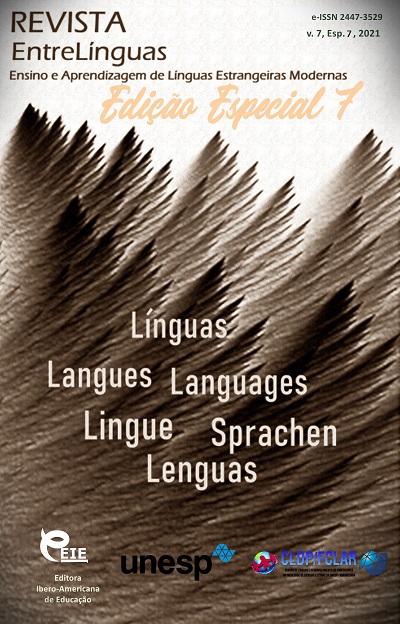Trends in the formation of the image of russia in foreign media by the example of the eurasian and american press
DOI:
https://doi.org/10.29051/el.v7iesp.7.16309Keywords:
Image of russia, Euro-asian media, American press, Media space, Image transformationAbstract
The nation's vision in international media is a close representation of the world community's nature to its global policy and financial plan and the efficiency of its power arrangements. The significance of this study is to analyze the status of modern Russia on the world stage and those international policies and financial circumstances that hold a significant impact on forming the vision of the Russian state in global media. It is desirable to see the inclinations in creating and transforming the modern Russian representation in the foreign press of the USA. The ordered frame of the research incorporates the international policy of the Russian Federation from 2014 to 2018, which is because of several major geopolitical issues with the cooperation of Russia, which essentially transformed the status of the Russian Federation worldwide.
Downloads
References
ALVERMANN, D.E. Critical media literacy: research, theory and practice in "new times". D.E. Alvermann, M.C. Hagood. Journal of Education Research, 93, 193-205. 2000.
BABENKO, L.G. Philological analysis of the text. Fundamentals of the theory, principles and aspects of analysis. 2004.
BIGNELL, J. Media semiotics: an introduction.— 2nd ed.— Manchester: Manchester University Press,.— XIV, 241 p. 2002.
BOOSTROM, R. Thinking: the foundation of critical and creative learning in the classroom. New York: Teachers College Press, 179 p. 2005.
BRUSHLINSKY, A.B. Thinking and prediction. M., 197 p. 1979.
BRYANT, J. Fundamentals of media effects. Boston: McGraw-Hill,. — 395 p. 2002.
BUCKINGHAM, D. Media education and the end of the critical consumer / D. Buckingham. Harvard Educational Review, 73(3), 309-327. 2003a
FATYKHOVA, M.KH., & SPIRCHAGOVA, T.A. The development of national broadcasting as a powerful factor in preserving cultural identity in the regions of Russia. Bulletin of the Chuvash University. Series "Humanities", 4, 173-177. 2015.
FREEDMAN, D. Internet transformations: old media resilience in the "new media" revolution. Media and Cultural theory. J. Curran, D. Morley, (Eds.). — London: Routledge, 275-290. 2006.
GRISHAEV, L.I., PASTUKHOV, A.G., & CHERNYSHOVA, T.V. (ED.) Media text: strategies - functions - style: collective monograph. - Orel: Orel State Institute of Arts and Culture, Horizont Printing Company, - 226 p. 2010.
KOROTKOVA, E.N. Media portal as a means of creating quality content. Screen culture of the XXI century. - M.: Publishing house 625, - P. 380. 2016.
NAZAROV, M.M. Mass communication in the modern world: analysis methodology and research practice. - M., 189 p. 2015.
Pocheptsov, G.G. News pressurized non-news trends. / URL: http://osvita.mediasapiens.ua/ethics/manipulation/novosti_po d_davleniem_nenovostnykh_tendentsiy.
Pocheptsov, G.G. News under the pressure of non-news trends / URL: http://osvita.mediasapiens.ua/ethics//manipulation/ novosti_pod_davleniem_nenovostnykh_tendentsiy / (access date: April 22, 2018)
VOLODINA, M.N. (ED.) Textbook for High Schools.- M.; Academic Project; Alma Mater,.-- 760 p .; Leontiev A.A. Selected psychological works. Vol. 1 / Edited by V.V. Davydova et al. - M.: Pedagogy, 1983. - 380 p. 2008.
Downloads
Published
How to Cite
Issue
Section
License

This work is licensed under a Creative Commons Attribution-NonCommercial-ShareAlike 4.0 International License.
Os manuscritos aceitos e publicados são de propriedade da Revista EntreLínguas. Os artigos publicados e as referências citadas na Revista EntreLínguas são de inteira responsabilidade de seus autores.
Transferência de direitos autorais – autorização para publicação
Caso o artigo submetido seja aprovado para publicação, já fica acordado que o(s) autor(es) autoriza(m) a UNESP a reproduzi-lo e publicá-lo na EntreLínguas, entendendo-se os termos “reprodução” e “publicação” conforme definição respectivamente dos incisos VI e I do artigo 5° da Lei 9610/98. O artigo poderá ser acessado pela rede mundial de computadores (Internet), sendo permitidas, a título gratuito, a consulta e a reprodução de exemplar do artigo para uso próprio de quem a consulta, desde que haja a citação ao texto consultado. Essa autorização de publicação 328 EntreLínguas, Araraquara, v. 1, n .2, p. 323-328, jul./dez. 2015 não tem limitação de tempo, ficando a UNESP responsável pela manutenção da identificação do(s) autor(es) do artigo. Os artigos publicados e as referências citadas na Revista EntreLínguas são de inteira responsabilidade de seus autores.











